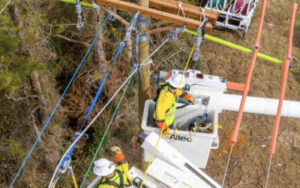
In the world of telecom, aerial splicing plays a crucial role in ensuring seamless connectivity and efficient transmission of data. Understanding aerial splicing and its key components is essential for anyone involved in the telecom industry. Additionally, hiring professional contractors for aerial splicing is of utmost importance to ensure quality assurance and adherence to safety measures. In Austin, there are leading aerial splicing contractors who offer a wide range of services to meet the telecom needs of businesses and individuals. The future of aerial splicing in telecom looks promising, with ongoing technological advances making significant impacts on industry growth.
Understanding Aerial Splicing in Telecom
Aerial splicing refers to the process of joining or connecting telecommunication cables using splicing techniques, typically performed at elevated locations such as utility poles or towers. This method of splicing is widely used in telecom networks to establish seamless connectivity and ensure efficient data transmission. It involves joining two or more cables using various splicing techniques, such as fusion splicing or mechanical splicing.
The Role of Aerial Splicing in Telecom
Aerial splicing plays a critical role in the establishment and maintenance of a reliable telecom infrastructure. It allows for the extension of existing networks, the installation of new connections, and the optimization of signal strength and quality. Aerial splicing also enables telecom companies to quickly respond to network repair or upgrade requirements, ensuring uninterrupted communication.
Key Components of Aerial Splicing
For successful aerial splicing, several key components are involved. These include fiber optic cables, splice closures, fiber optic connectors, fusion splicers, and mechanical splicing tools. Fiber optic cables are designed to transmit data at high speeds over long distances, while splice closures protect the spliced connections from environmental factors. Fiber optic connectors and fusion splicers are used to join the individual fiber optic cables, and mechanical splicing tools offer an alternative splicing method.
Let’s delve deeper into the fascinating world of aerial splicing. One important aspect to consider is the selection of the appropriate splicing technique for a specific telecom project. Fusion splicing, for instance, is a widely used method that involves melting the fiber ends together using an electric arc. This creates a permanent and low-loss connection, ensuring optimal signal transmission. On the other hand, mechanical splicing involves aligning the fiber ends and securing them with a mechanical splice, which does not require heat. This method is often preferred for quick repairs or temporary connections.
When it comes to fiber optic cables, there are different types available, each with its own unique characteristics. Single-mode fiber optic cables are designed for long-distance transmission, while multi-mode fiber optic cables are suitable for shorter distances. The choice of cable depends on the specific requirements of the telecom network, such as the distance between splicing points and the desired data transmission speed.
Another crucial component in aerial splicing is the splice closure. These protective enclosures are designed to safeguard the spliced connections from harsh environmental conditions, such as extreme temperatures, moisture, and physical damage. They provide a secure and reliable housing for the spliced fibers, ensuring the longevity and performance of the telecom network.
The Importance of Hiring Professional Contractors
When it comes to aerial splicing in telecom, hiring professional contractors is of paramount importance. Professional contractors possess the necessary expertise, experience, and specialized tools to ensure that the splicing process is carried out safely and efficiently. They follow industry best practices, adhere to safety guidelines, and deliver quality workmanship that meets the highest standards.
Furthermore, professional contractors stay updated on the latest technological advancements in aerial splicing. They undergo continuous training to enhance their skills and stay informed about new techniques and equipment in the industry. This commitment to ongoing education ensures that they can provide cutting-edge solutions to their clients and deliver superior results.
Quality Assurance in Telecom Services
Professional aerial splicing contractors prioritize quality assurance in their services. They conduct thorough testing and inspections to ensure that the spliced connections meet the required performance standards. With their expertise, they can troubleshoot any connectivity issues and make necessary adjustments to optimize signal strength and reliability.
In addition, professional contractors maintain detailed records of their work and testing procedures. This documentation not only serves as a reference for future maintenance and upgrades but also provides transparency and accountability to clients. By keeping meticulous records, contractors demonstrate their commitment to quality and professionalism in every aspect of their service.
Safety Measures in Aerial Splicing
Aerial splicing involves working at heights and dealing with sensitive equipment, making safety a top priority. Professional contractors have rigorous safety protocols in place to protect their workers and the public. They adhere to safety regulations, use appropriate safety gear, and implement proper risk assessment measures to minimize any potential hazards associated with the splicing process.
Moreover, professional contractors conduct regular safety audits and inspections to ensure that their work environments meet the highest safety standards. By proactively identifying and addressing safety concerns, contractors create a secure and compliant workspace for their team members. This proactive approach not only mitigates risks but also fosters a culture of safety consciousness and responsibility among all personnel involved in the aerial splicing process.
Austin’s Leading Aerial Splicing Contractors
In Austin, there are reputable aerial splicing contractors who excel in providing top-notch telecom services. These contractors offer a range of services catered to the specific needs of businesses and individuals in the area.
Services Offered by Austin Contractors
Austin’s leading aerial splicing contractors offer a comprehensive range of services, including aerial cable installation, network design and optimization, fiber optic splicing and testing, aerial maintenance and repair, and emergency response services. They have the expertise to handle projects of all sizes, from small-scale installations to large-scale network deployments.
Why Choose Austin’s Contractors for Your Telecom Needs
Choosing Austin’s aerial splicing contractors for your telecom needs provides numerous benefits. With their in-depth knowledge of the local telecom landscape and regulations, they can navigate any unique challenges specific to the area. Austin’s contractors also pride themselves on their commitment to customer satisfaction, delivering reliable and efficient services that meet the individual requirements of their clients.
The Future of Aerial Splicing in Telecom
The future of aerial splicing in the telecom industry looks promising, with continuous technological advances making significant impacts on the efficiency and effectiveness of the splicing process.
Technological Advances in Aerial Splicing
Ongoing advancements in aerial splicing technologies are revolutionizing the telecom industry. Innovations such as automated splicing machines, improved fiber optic cables, and enhanced splice closures are making the splicing process faster, more accurate, and less prone to errors. These technological advancements not only increase efficiency but also contribute to improved network performance and reliability.
The Impact of Aerial Splicing on Telecom Industry Growth
Aerial splicing plays a pivotal role in supporting the growth of the telecom industry. As the demand for high-speed internet and seamless connectivity continues to rise, the need for robust and reliable telecom infrastructure becomes increasingly essential. Aerial splicing allows for the expansion and optimization of telecom networks, facilitating the delivery of high-quality services to an ever-growing customer base.
In conclusion, aerial splicing in telecom is a critical process that ensures the establishment and maintenance of reliable communication networks. Hiring professional contractors for aerial splicing in Austin guarantees quality workmanship and adherence to safety measures. With ongoing technological advances, the future of aerial splicing in the telecom industry looks promising, paving the way for improved network performance and industry growth.
As the telecom industry continues to evolve, the expertise of Whitmore Construction becomes increasingly vital for businesses looking to expand and maintain their utility construction needs. With our comprehensive turn-key network services, including design, engineering, and a focus on aerial splicing, we are equipped to support the growth and reliability of your telecom infrastructure. Our commitment to safety, quality, and customer service, combined with our ability to deploy thousands of miles of cable both aerially and underground, positions us as a leader in the telecommunications industry. Whether it’s new construction, repairs, or maintenance for distribution lines, transmission lines, or power substations, Whitmore Construction is ready to exceed your expectations. Contact Us Today! to discuss how we can assist with your project and ensure its success with our experienced and fully insured team.
